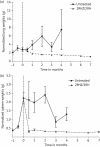Effectiveness of tuberculosis chemotherapy correlates with resistance to Mycobacterium tuberculosis infection in animal models
- PMID: 21602551
- PMCID: PMC3112031
- DOI: 10.1093/jac/dkr188
Effectiveness of tuberculosis chemotherapy correlates with resistance to Mycobacterium tuberculosis infection in animal models
Abstract
Objectives: It is widely believed that persistent Mycobacterium tuberculosis inhabits necrotic lung granulomas in humans and that the microenvironmental conditions encountered therein render the bacilli phenotypically tolerant to antibiotics, accounting for the long duration required for successful treatment of tuberculosis (TB). To validate this belief, we directly compared the activity of rifampicin/isoniazid/pyrazinamide (RHZ) against chronic TB infection in guinea pigs, which exhibit caseous granulomas histologically resembling human caseous foci, and in mice, which lack necrotic granulomas.
Methods: Guinea pigs and mice were aerosol-infected with M. tuberculosis CDC1551 and twice weekly treatment with RHZ was started 4 weeks later. Culture-positive relapse was assessed in subgroups of guinea pigs after 3 months and 4 months of treatment.
Results: All guinea pig lungs exhibited histological evidence of granulomas with central caseation, while mouse lungs exhibited cellular lesions at the initiation of antibiotic treatment. Guinea pig lungs became culture-negative after 2 months of RHZ given twice weekly at human-equivalent doses. Relapse rates in guinea pigs were 0% (0/10) both after 3 months and 4 months of treatment. In contrast, all mouse lungs remained culture-positive after 4 months of equivalent RHZ exposures.
Conclusions: Caseous necrosis does not reduce the sterilizing activity of the standard antituberculosis regimen of RHZ. Our findings have important implications for the use of alternative animal models in testing novel TB drug regimens and for modelling M. tuberculosis persistence.
Figures



Similar articles
-
Potent rifamycin-sparing regimen cures guinea pig tuberculosis as rapidly as the standard regimen.Antimicrob Agents Chemother. 2013 Aug;57(8):3910-6. doi: 10.1128/AAC.00761-13. Epub 2013 Jun 3. Antimicrob Agents Chemother. 2013. PMID: 23733473 Free PMC article.
-
Comparison of the 'Denver regimen' against acute tuberculosis in the mouse and guinea pig.J Antimicrob Chemother. 2010 Apr;65(4):729-34. doi: 10.1093/jac/dkq007. Epub 2010 Jan 31. J Antimicrob Chemother. 2010. PMID: 20123722 Free PMC article.
-
Rifapentine is not more active than rifampin against chronic tuberculosis in guinea pigs.Antimicrob Agents Chemother. 2012 Jul;56(7):3726-31. doi: 10.1128/AAC.00500-12. Epub 2012 Apr 30. Antimicrob Agents Chemother. 2012. PMID: 22547623 Free PMC article.
-
Fighting tuberculosis by drugs targeting nonreplicating Mycobacterium tuberculosis bacilli.Int J Mycobacteriol. 2017 Jul-Sep;6(3):213-221. doi: 10.4103/ijmy.ijmy_85_17. Int J Mycobacteriol. 2017. PMID: 28776518 Review.
-
[Trends in tuberculosis treatment duration].Presse Med. 2006 Nov;35(11 Pt 2):1758-1764. doi: 10.1016/S0755-4982(06)74895-3. Presse Med. 2006. PMID: 17086138 Review. French.
Cited by
-
Vaccination with recombinant Mycobacterium tuberculosis PknD attenuates bacterial dissemination to the brain in guinea pigs.PLoS One. 2013 Jun 11;8(6):e66310. doi: 10.1371/journal.pone.0066310. Print 2013. PLoS One. 2013. PMID: 23776655 Free PMC article.
-
De Novo Emergence of Genetically Resistant Mutants of Mycobacterium tuberculosis from the Persistence Phase Cells Formed against Antituberculosis Drugs In Vitro.Antimicrob Agents Chemother. 2017 Jan 24;61(2):e01343-16. doi: 10.1128/AAC.01343-16. Print 2017 Feb. Antimicrob Agents Chemother. 2017. PMID: 27895008 Free PMC article.
-
Potent rifamycin-sparing regimen cures guinea pig tuberculosis as rapidly as the standard regimen.Antimicrob Agents Chemother. 2013 Aug;57(8):3910-6. doi: 10.1128/AAC.00761-13. Epub 2013 Jun 3. Antimicrob Agents Chemother. 2013. PMID: 23733473 Free PMC article.
-
Sterilizing activity of novel TMC207- and PA-824-containing regimens in a murine model of tuberculosis.Antimicrob Agents Chemother. 2011 Dec;55(12):5485-92. doi: 10.1128/AAC.05293-11. Epub 2011 Sep 19. Antimicrob Agents Chemother. 2011. PMID: 21930883 Free PMC article.
-
Simvastatin increases the in vivo activity of the first-line tuberculosis regimen.J Antimicrob Chemother. 2014 Sep;69(9):2453-7. doi: 10.1093/jac/dku166. Epub 2014 May 22. J Antimicrob Chemother. 2014. PMID: 24855121 Free PMC article.
References
-
- Fauci AS. Multidrug-resistant and extensively drug-resistant tuberculosis: the National Institute of Allergy and Infectious Diseases Research agenda and recommendations for priority research. J Infect Dis. 2008;197:1493–8. doi:10.1086/587904. - DOI - PubMed
-
- Vandiviere HM, Loring WE, Melvin I, et al. The treated pulmonary lesion and its tubercle bacillus. II. The death and resurrection. Am J Med Sci. 1956;232:30–7. passim doi:10.1097/00000441-195607000-00006. - DOI - PubMed
-
- Tomasz A, Albino A, Zanati E. Multiple antibiotic resistance in a bacterium with suppressed autolytic system. Nature. 1970;227:138–40. doi:10.1038/227138a0. - DOI - PubMed
-
- McCune RM, Jr, McDermott W, Tompsett R. The fate of Mycobacterium tuberculosis in mouse tissues as determined by the microbial enumeration technique. II. The conversion of tuberculous infection to the latent state by the administration of pyrazinamide and a companion drug. J Exp Med. 1956;104:763–802. doi:10.1084/jem.104.5.763. - DOI - PMC - PubMed
-
- Flynn J, Chan J. Animal models of tuberculosis. In: Rom W, Garay S, editors. Tuberculosis. Philadelphia: Lippincott Williams & Wilkins; 2004. pp. 237–50.
Publication types
MeSH terms
Substances
Grants and funding
LinkOut - more resources
Full Text Sources
Medical

